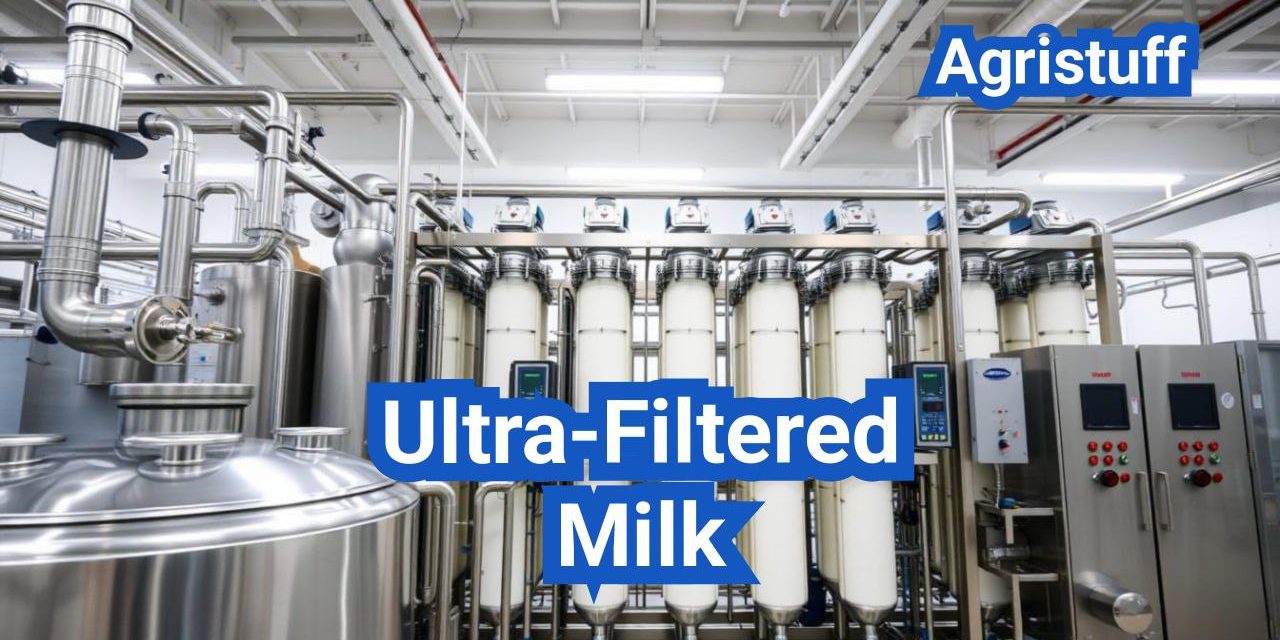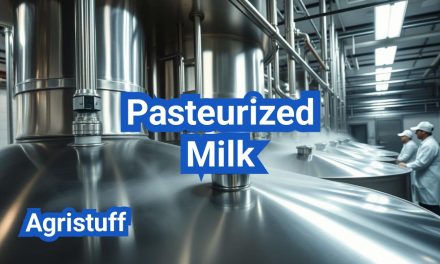The dairy industry has seen a rise in high-protein milk and low-sugar milk products, with ultra-filtered milk being a significant player. This type of milk undergoes an ultrafiltration dairy process, which involves passing it through a semipermeable membrane to separate components by molecular size.
The result is a product with a higher protein content and lower sugar levels compared to regular milk. Consumers are increasingly drawn to this variant due to its nutritional benefits and taste.
Key Takeaways
- Ultra-filtered milk has higher protein and lower sugar content.
- The ultrafiltration process involves a semipermeable membrane.
- This process enhances the nutritional profile of the milk.
- Consumers prefer ultra filtered milk for its health benefits.
- It is a variant of milk that is gaining popularity.
What Is Ultra-Filtered Milk?
Understanding ultra-filtered milk starts with knowing how it’s made. Ultra filtered milk is a type of milk that has been processed using a semipermeable membrane to filter out smaller molecules like lactose and water, resulting in a product with higher protein and lower sugar content.
Definition and Basic Concept
Ultra-filtered milk is defined by its unique processing method, where milk is passed through membranes with pores small enough to retain proteins, calcium, and other desirable components while allowing water and smaller molecules like lactose to pass through. This process concentrates the protein and reduces the lactose content, making it a popular choice for those seeking higher protein and lower sugar dairy products.
The basic concept revolves around enhancing the nutritional profile of milk by adjusting its composition through filtration. This not only improves the taste but also caters to the growing demand for healthier dairy options.
History and Development
The concept of ultra-filtered milk has been around for a few decades, originating from the need to improve the efficiency of dairy processing and enhance the nutritional content of milk. Initially developed in Europe, the technology has evolved over the years, becoming more refined and accessible to a broader market.
The development of ultra filtered milk involved significant advancements in membrane technology, allowing for more precise control over the filtration process. This has enabled manufacturers to produce milk with consistent quality and tailored nutritional profiles.
Growing Popularity in the United States
In recent years, ultra-filtered milk has gained significant popularity in the United States. This growth can be attributed to increasing consumer awareness of the benefits associated with higher protein and lower sugar dairy products. Fitness enthusiasts and health-conscious individuals have been particularly drawn to ultra-filtered milk for its nutritional advantages.
The market has responded by offering a variety of ultra-filtered milk products, from brands like Fairlife, which has been at the forefront of this trend. As consumers continue to seek out healthier and more functional dairy options, the popularity of ultra-filtered milk is expected to grow.
The Science Behind Ultra Filtration in Dairy

Understanding the process of ultra-filtration is key to appreciating its impact on dairy products. Ultra-filtration involves using a semipermeable membrane to separate milk components based on molecular size, resulting in a higher protein and lower lactose product.
Understanding the Ultrafiltration Process
The ultrafiltration process is a critical step in producing ultra-filtered milk. It involves passing milk through a semipermeable membrane with pores that allow water, lactose, and minerals to pass through while retaining larger molecules like proteins and fats. This process not only concentrates the desirable components but also removes excess lactose, making the milk more suitable for those with dietary restrictions.
As noted by dairy experts, “The use of ultrafiltration in dairy processing has opened up new avenues for creating products with enhanced nutritional profiles.” This technology is particularly beneficial for producing milk with higher protein content, which is a growing consumer preference.
Membrane Technology Explained
The membrane used in ultrafiltration is a crucial element, with its pore size determining what passes through and what is retained. The technology behind these membranes involves creating a thin, selective barrier that can filter out particles as small as 0.01 microns. This selective filtration is what allows for the concentration of proteins and the removal of lactose.
Diafiltration: The Next Step
Diafiltration is an additional step that can be used in conjunction with ultrafiltration to further purify the milk. By adding water to the milk during the filtration process, diafiltration enhances the removal of lactose and minerals, resulting in a product that is even more concentrated in proteins. This step is particularly useful for producing lactose-free or low-lactose milk products.
Differences from Traditional Pasteurization
Unlike traditional pasteurization, which involves heating milk to kill bacteria, ultrafiltration is a non-thermal process that preserves the nutritional integrity of the milk. While pasteurization is essential for safety, ultrafiltration offers an additional layer of processing that can enhance the nutritional profile and taste of the milk. As a result, ultra-filtered milk is often described as having a richer, creamier taste compared to traditionally processed milk.
The combination of ultrafiltration and diafiltration represents a significant advancement in dairy processing technology, enabling the production of milk products that are not only safer but also more nutritious and appealing to consumers.
How Ultra-Filtered Milk Is Processed: Step-by-Step Guide
The production of ultra-filtered milk involves a meticulous process that starts with the careful preparation of raw milk. This process is crucial in ensuring the final product is of high quality and meets nutritional standards.
Preparation of Raw Milk
The journey begins with the selection and preparation of raw milk. Raw milk is sourced from local dairy farms and transported to the processing facility. Upon arrival, the milk is tested for quality and purity before being stored in refrigerated silos. Proper handling at this stage is critical to prevent contamination and ensure the milk’s natural nutrients are preserved.
Filtration Process Steps
The raw milk then undergoes a series of filtration processes. The first step involves microfiltration, where the milk is passed through membranes with tiny pores to remove bacteria and other pathogens. Following this, the milk is subjected to ultrafiltration, a process that concentrates the milk proteins and reduces the lactose content.
- The milk is forced through semi-permeable membranes under pressure.
- The membranes allow water and small molecules like lactose to pass through while retaining larger molecules such as proteins and fats.
- This process not only concentrates the desired nutrients but also improves the milk’s overall quality and shelf life.
Quality Control Measures
After filtration, the ultra-filtered milk undergoes rigorous quality control checks. These include testing for nutritional content, bacterial count, and taste. The milk is also checked for its protein and lactose levels to ensure it meets the required standards. Only batches that pass these tests are packaged and distributed to stores.
By understanding the step-by-step process involved in producing ultra-filtered milk, consumers can appreciate the care and technology that goes into creating this nutritious dairy product.
Nutritional Profile of Ultra-Filtered Milk

Ultra-filtered milk offers a distinct nutritional profile that is rich in protein and calcium, making it an attractive option for those seeking a healthier dairy choice. This type of milk has undergone a filtration process that not only concentrates the protein and calcium but also reduces the sugar content, resulting in a more balanced nutritional composition.
Protein Content Analysis
One of the significant advantages of ultra-filtered milk is its high protein content. The ultrafiltration process removes excess water and concentrates the proteins, resulting in a product that contains nearly twice the amount of protein as regular milk. For instance, a cup of ultra-filtered milk can contain around 13 grams of protein, making it an excellent choice for athletes and individuals looking to increase their protein intake.
Sugar and Carbohydrate Levels
Ultra-filtered milk also boasts lower sugar and carbohydrate levels compared to traditional milk. The filtration process reduces the lactose content, making it a more suitable option for those monitoring their sugar intake. A comparison of the nutritional labels reveals that ultra-filtered milk contains significantly less sugar than regular milk, with some brands offering as little as 6 grams of sugar per cup.
Calcium and Other Nutrients
In addition to its high protein content, ultra-filtered milk is also rich in calcium and other essential nutrients. The concentration process ensures that these minerals are more densely packed, providing a more nutritious beverage. Ultra-filtered milk is an excellent source of calcium, vitamin D, and potassium, making it a nutritious addition to a balanced diet.
Caloric Content Comparison
When comparing the caloric content of ultra-filtered milk to regular milk, the differences are notable. While the exact caloric content can vary by brand, ultra-filtered milk generally contains around 120-150 calories per cup, slightly more than regular milk due to its higher protein content. However, the nutritional benefits often outweigh the slight increase in calories.
| Nutrient | Ultra-Filtered Milk (per cup) | Regular Milk (per cup) |
|---|---|---|
| Protein | 13g | 8g |
| Sugar | 6g | 12g |
| Calcium | 300mg | 300mg |
| Calories | 120-150 | 100-120 |
Ultra-Filtered Milk vs. Regular Milk: Key Differences
Understanding the differences between ultra-filtered milk and regular milk can help consumers make informed decisions about their dairy choices.
Taste and Texture Comparison
Ultra-filtered milk has a creamier texture and a richer taste compared to regular milk. This is due to the filtration process that removes more water and concentrates the nutrients.
“The smoother texture and more pronounced flavor make ultra-filtered milk a favorite among consumers looking for a premium dairy experience,” says a dairy industry expert.
Nutritional Differences
One of the significant advantages of ultra-filtered milk is its higher protein content and lower sugar levels compared to regular milk.
| Nutrient | Ultra-Filtered Milk | Regular Milk |
|---|---|---|
| Protein | 13g | 8g |
| Sugar | 6g | 12g |
Shelf Life Advantages
Ultra-filtered milk often has a longer shelf life due to its processing method, which includes ultra-high temperature (UHT) treatment. This makes it more convenient for consumers.
Price Point Considerations
While ultra-filtered milk offers several benefits, it is generally priced higher than regular milk. Consumers must weigh the advantages against the additional cost.
Understanding Lactose Content in Ultra-Filtered Milk

Understanding the lactose content in ultra-filtered milk requires a closer look at its production process. Ultra-filtered milk has gained attention for its potential to be a lower-lactose alternative to traditional milk, making it an interesting option for those with lactose intolerance.
Lactose Reduction Process
The ultrafiltration process involves forcing the milk through a semi-permeable membrane, which filters out larger molecules, including some of the lactose. This process not only concentrates the protein and calcium but also reduces the lactose content.
Lactose reduction is a significant benefit for individuals who are lactose intolerant. The process doesn’t completely eliminate lactose, but it reduces it to levels that may be more tolerable for some.
Comparing with Traditional Lactose-Free Options
Traditional lactose-free milk is made by adding lactase, an enzyme that breaks down lactose into easily digestible sugars. In contrast, ultra-filtered milk achieves its lower lactose content through mechanical filtration.
| Characteristics | Ultra-Filtered Milk | Traditional Lactose-Free Milk |
|---|---|---|
| Lactose Reduction Method | Ultrafiltration | Enzyme (Lactase) Addition |
| Protein Content | Higher | Similar to regular milk |
| Taste and Texture | Thicker, creamier | Similar to regular milk |
Suitability for Lactose-Intolerant Individuals
While ultra-filtered milk is not completely lactose-free, its reduced lactose content can make it a more comfortable choice for some lactose-intolerant individuals. However, it’s essential for those with severe lactose intolerance to consult with a healthcare provider before consuming ultra-filtered milk.
In conclusion, ultra-filtered milk offers a unique alternative to traditional lactose-free options, with its lactose content reduced through ultrafiltration. This makes it a potentially suitable choice for those looking to manage their lactose intake.
Health Benefits of Ultra-Filtered Milk

Ultra-filtered milk offers a range of health benefits that make it an excellent addition to a balanced diet. With its unique nutritional profile, it caters to various dietary needs and preferences.
Advantages for Protein-Focused Diets
One of the significant benefits of ultra-filtered milk is its high protein content. Ultra-filtered milk contains a higher concentration of protein compared to regular milk, making it an ideal choice for individuals on protein-focused diets. This is particularly beneficial for athletes and fitness enthusiasts who require a higher protein intake to support muscle growth and recovery.
Benefits for Diabetics and Blood Sugar Management
Ultra-filtered milk is also beneficial for diabetics due to its lower sugar content. The ultrafiltration process reduces the lactose levels, making it a more suitable option for those managing their blood sugar levels. By consuming ultra-filtered milk, diabetics can enjoy a dairy product with less impact on their glucose levels.
Calcium Absorption and Bone Health
The calcium content in ultra-filtered milk is another significant health benefit. Calcium is crucial for bone health, and ultra-filtered milk provides an easily absorbable form of this essential mineral. Regular consumption can contribute to stronger bones and teeth, reducing the risk of osteoporosis and fractures.
Weight Management Potential
Ultra-filtered milk can also aid in weight management. The high protein content helps in satiety, reducing the likelihood of overeating. Additionally, the lower sugar content makes it a healthier alternative to regular milk for those monitoring their calorie intake.
Microfiltered vs. Ultra-Filtered Milk: Understanding the Difference

Understanding the differences between microfiltered and ultra-filtered milk is crucial for consumers looking to make informed choices about their dairy intake. Both types of milk have gained popularity due to their unique processing methods, which affect their nutritional content and taste.
Filtration Technology Comparison
The primary difference between microfiltered and ultra-filtered milk lies in their filtration technologies. Microfiltered milk uses a process that removes bacteria and extends shelf life without significantly altering the milk’s nutritional profile. In contrast, ultra-filtered milk undergoes a more rigorous filtration process that not only removes bacteria but also concentrates the protein and reduces lactose levels.
Nutritional Differences
The nutritional differences between microfiltered and ultra-filtered milk are notable. Ultra-filtered milk typically has higher protein content and lower sugar levels compared to microfiltered milk. This makes ultra-filtered milk a popular choice among fitness enthusiasts and those monitoring their sugar intake.
Best Uses for Each Type
Choosing between microfiltered and ultra-filtered milk depends on individual needs. For those seeking higher protein and lower sugar, ultra-filtered milk is the better choice. Key uses include:
- Protein shakes and post-workout nutrition
- Cooking and baking where higher protein is beneficial
- Diets requiring lower sugar intake
Microfiltered milk, on the other hand, is suitable for those looking for a milk with a less processed taste and a slightly longer shelf life than regular milk.
Popular Ultra-Filtered Milk Brands in the Market

Fairlife and Organic Valley are among the prominent brands that have capitalized on the ultra-filtered milk trend. These brands have not only gained consumer trust but have also set a high standard in the industry.
Fairlife: The Market Leader
Fairlife has been at the forefront of the ultra-filtered milk market. Their products are known for higher protein content and lower sugar levels compared to traditional milk. Fairlife’s ultra-filtered milk is a favorite among fitness enthusiasts and health-conscious consumers.
Organic Valley Ultra-Filtered Options
Organic Valley offers organic ultra-filtered milk that caters to consumers looking for organic and sustainable options. Their products are made from milk sourced from organic farms, ensuring a high-quality and environmentally friendly product.
Other Notable Brands and Products
Besides Fairlife and Organic Valley, other brands are making a mark in the ultra-filtered milk market. Some of these include:
| Brand | Product | Key Feature |
|---|---|---|
| Fairlife | Ultra-Filtered Milk | High Protein, Low Sugar |
| Organic Valley | Organic Ultra-Filtered Milk | Organic, Sustainable |
| Core Power | Ultra-Filtered Milkshake | Protein-Rich, Convenient |
The ultra-filtered milk market is diverse, with various brands offering unique products that cater to different consumer needs. Whether you’re looking for high protein, organic, or low sugar options, there’s an ultra-filtered milk brand that’s right for you.
How to Use Ultra-Filtered Milk in Your Diet

Ultra-filtered milk is a versatile ingredient that can elevate your coffee, recipes, and overall diet. With its high protein content and reduced sugar levels, it offers a nutritious alternative to traditional milk. Here are some ways you can incorporate ultra-filtered milk into your daily routine.
Using Ultra-Filtered Milk in Coffee and Beverages
Ultra-filtered milk can be a fantastic addition to your morning coffee, providing a creamy texture without the need for additional creamers. Its high protein content also makes it an excellent choice for post-workout smoothies or as a base for other beverages.
Tips for using ultra-filtered milk in coffee:
- Use it as a direct substitute for regular milk.
- Froth it for a cappuccino or latte.
- Mix it with coffee for a protein-packed cold brew.
Cooking and Baking with Ultra-Filtered Milk
Cooking and baking with ultra-filtered milk can enhance the nutritional profile of your dishes. Its higher protein content can improve the texture of baked goods, while its lower sugar content makes it a healthier option for desserts.
Try using ultra-filtered milk in:
- Pancake and waffle batter for a protein boost.
- Custards and puddings for a creamier texture.
- Casseroles and soups for added nutrition.
Creating Protein Shakes with Ultra-Filtered Milk
Ultra-filtered milk is an excellent base for protein shakes due to its high protein content. You can blend it with your favorite fruits, nuts, and protein powders to create a nutritious and filling shake.
Ultra-Filtered Milkshake Recipes
Indulge in delicious and healthy milkshakes made with ultra-filtered milk. Here are a few ideas:
- Strawberry Banana Milkshake: Blend ultra-filtered milk with strawberries, banana, and a touch of honey.
- Chocolate Protein Milkshake: Mix ultra-filtered milk with cocoa powder, protein powder, and a handful of ice.
By incorporating ultra-filtered milk into your diet, you can enjoy a range of delicious and nutritious beverages and dishes. Experiment with different recipes and uses to find your favorite ways to enjoy ultra-filtered milk.
Ultra-Filtered Milk for Special Dietary Needs

The nutritional profile of ultra-filtered milk makes it an ideal choice for various special diets. Its unique processing method enhances its suitability for different nutritional needs.
Athletes and Fitness Enthusiasts
Ultra-filtered milk is particularly beneficial for athletes due to its high protein content, which supports muscle recovery and growth. Brands like Fairlife offer ultra-filtered milk with 13 grams of protein per serving, making it a popular choice among fitness enthusiasts.
Benefits for Diabetics and Low-Sugar Diets
For diabetics, ultra-filtered milk is a good option because it contains less sugar compared to regular milk. The filtration process reduces lactose, making it easier to consume for those with dietary restrictions. Ultra-filtered milk can be a valuable part of a low-sugar diet.
Ultra-Filtered Milk in Children’s Nutrition
Children can benefit from the enhanced nutritional profile of ultra-filtered milk, particularly its high calcium content, which is crucial for bone development. Parents looking for a nutritious milk option for their children may find ultra-filtered milk to be a healthy choice.
Considerations for Elderly Nutrition
For the elderly, ultra-filtered milk provides essential nutrients that support overall health. Its high protein content can help maintain muscle mass, while its calcium content supports bone health.
| Nutritional Benefit | Ultra-Filtered Milk | Regular Milk |
|---|---|---|
| Protein Content | 13g per serving | 8g per serving |
| Sugar Content | Reduced lactose | Higher lactose |
| Calcium Content | High calcium | Standard calcium |
UHT and ESL Processing in Ultra-Filtered Milk

The use of UHT and ESL processing technologies in ultra-filtered milk production is a game-changer for consumers seeking convenience without compromising on quality. These advanced processing methods significantly extend the shelf life of ultra-filtered milk, making it a more practical choice for a wider range of consumers.
Understanding UHT (Ultra-High Temperature) Processing
UHT processing involves heating the milk to a very high temperature for a short period, followed by rapid cooling. This process effectively kills bacteria and extends the shelf life of the milk without refrigeration until it’s opened. UHT ultra-filtered milk is particularly beneficial for consumers who do not consume milk frequently or live in areas with limited refrigeration.
Extended Shelf Life (ESL) Technology
ESL technology, on the other hand, involves microfiltration and a mild heat treatment. This method also aims to extend shelf life but uses a different approach than UHT. ESL milk is often preferred by consumers who are sensitive to the taste changes associated with UHT processing.
Impact on Taste and Nutrition
Both UHT and ESL processing methods have varying impacts on the taste and nutritional content of ultra-filtered milk. While UHT can slightly alter the taste due to the high heat, ESL is generally considered to preserve the natural taste better. Nutritionally, both methods aim to retain the high protein and low sugar benefits of ultra-filtered milk.
Storage Requirements
One of the significant advantages of UHT and ESL processed ultra-filtered milk is its storage convenience. UHT milk, in particular, can be stored without refrigeration until opened, making it highly convenient for certain consumers. However, once opened, it should be refrigerated and consumed within a few days.
Is Ultra-Filtered Milk Right for You?
Ultra-filtered milk has emerged as a nutritious dairy option, offering higher protein and lower sugar content compared to regular milk. The unique filtration process enhances the nutritional profile, making it suitable for those seeking a more wholesome dairy product.
When considering ultra-filtered milk vs regular milk, the differences in nutritional content and shelf life become apparent. Ultra-filtered milk provides several benefits, including advantages for protein-focused diets and blood sugar management. Brands like Fairlife and Organic Valley offer high-quality ultra-filtered milk products.
To determine if ultra-filtered milk is right for you, consider your dietary needs and preferences. If you’re looking for a more nutritious dairy option with higher protein and lower sugar content, ultra-filtered milk may be an excellent choice. Experiment with different brands and recipes to find the best way to incorporate ultra-filtered milk into your diet.
FAQ
What is ultra-filtered milk?
Ultra-filtered milk is a type of milk that has been processed using ultrafiltration technology, which removes excess water and concentrates the protein, calcium, and other nutrients, resulting in a higher protein and lower sugar content.
How does ultrafiltration affect the nutritional content of milk?
Ultrafiltration increases the protein content, reduces the sugar and carbohydrate levels, and retains the calcium and other essential nutrients, making it a more nutritious option compared to regular milk.
Is ultra-filtered milk lactose-free?
While ultrafiltration reduces the lactose content, it is not necessarily lactose-free. However, some ultra-filtered milk brands, like Fairlife, offer lactose-free options.
What is the difference between microfiltered and ultra-filtered milk?
Microfiltered milk uses a finer filtration process that removes bacteria and extends shelf life, whereas ultra-filtered milk uses a more advanced process that concentrates the protein and nutrients. Ultra-filtered milk generally has a higher protein content and lower sugar levels.
Can ultra-filtered milk be used in cooking and baking?
Yes, ultra-filtered milk can be used as a substitute for regular milk in cooking and baking, and its higher protein content can enhance the nutritional profile of various recipes.
Is ultra-filtered milk suitable for individuals with lactose intolerance?
Ultra-filtered milk can be a good option for those with lactose intolerance due to its reduced lactose content. However, it’s essential to check the label for lactose-free certification if you have a severe intolerance.
How does ultra-filtered milk compare to regular milk in terms of taste and texture?
Ultra-filtered milk has a richer and creamier texture compared to regular milk, and its taste is often described as more neutral or less sweet due to the reduced sugar content.
What are the benefits of ultra-filtered milk for athletes and fitness enthusiasts?
Ultra-filtered milk is an excellent source of protein, making it ideal for athletes and fitness enthusiasts who require high protein intake to support muscle growth and recovery.
Can ultra-filtered milk help with weight management?
The higher protein content in ultra-filtered milk can help with satiety and weight management, as protein takes longer to digest, keeping you fuller for longer.
Are there any notable brands that offer ultra-filtered milk?
Yes, Fairlife and Organic Valley are two prominent brands that offer ultra-filtered milk products. Other brands are also available in the market, offering a range of ultra-filtered milk options.
How should ultra-filtered milk be stored?
Ultra-filtered milk, especially UHT (Ultra-High Temperature) processed milk, can be stored at room temperature until opened. Once opened, it should be refrigerated and consumed within a few days.
Conclusion of: Ultra Filtered Milk
What is ultra filtered milk?
Ultra filtered milk is regular cow’s milk that passes through fine membranes to remove part of the water and lactose while concentrating proteins, leaving ultra filtered milk with more protein and less sugar than standard milk; in U.S. food policy, the FDA recognizes ultrafiltered milk as a mechanically filtered milk stream used widely in dairy processing FDA guidance on ultrafiltered milk.
How does ultrafiltration work in ultra filtered milk?
Inside the plant, liquid flows across semi-permeable membranes: small molecules like water and lactose form the permeate, while proteins and fat stay in the retentate; processors can “wash” the retentate with water (diafiltration) to drive out even more lactose before recombining, which is why ultra filtered milk reliably ends up higher in protein and lower in sugar than conventional milk Membrane & diafiltration overview.
Ultra filtered milk vs. microfiltration, nanofiltration, and reverse osmosis
Ultra filtered milk targets nutrient concentration (especially protein retention), whereas microfiltration is tuned to remove bacteria/spores, nanofiltration partially removes salts, and reverse osmosis focuses on water removal; knowing this helps you see why ultra filtered milk specifically boosts protein and cuts lactose compared with other filtered milks Filtration methods in dairy.
What changes nutritionally in ultra filtered milk?
Because ultrafiltration retains proteins and removes part of the lactose, ultra filtered milk commonly delivers around 50% more protein and roughly half the sugar per serving versus regular milk (brand formulas vary); one U.S. label lists 13 g protein and 6 g sugars per cup for whole ultra filtered milk, illustrating the typical shift consumers expect from ultra filtered milk Example nutrition facts.
Is ultra filtered milk lactose-free—and why can it taste slightly sweeter?
Ultrafiltration reduces lactose substantially, and many ultra filtered milk brands then add lactase to break remaining lactose into glucose and galactose; that makes ultra filtered milk lactose-free in most retail products and sometimes perceived as a bit sweeter even though the total sugar is lower than regular milk How lactose is reduced/removed.
How the U.S. labels and regulates ultra filtered milk
In cheese standards and ingredient supply, FDA has long allowed the use and labeling of ultrafiltered milk under enforcement discretion, while beverage ultra filtered milk on shelves follows standard food labeling, allergen, and safety rules; reading labels helps you verify “ultra-filtered milk” in the ingredient line and the protein/sugar amounts that distinguish ultra filtered milk from conventional milk FDA guidance document.
Protein, sugar, and mineral implications of ultra filtered milk
Because proteins are retained in the retentate, ultra filtered milk raises protein per cup and often maintains a strong mineral profile (including calcium), while cutting lactose-derived sugars; peer-reviewed studies of ultrafiltration and diafiltration explain how this composition shift occurs in ultra filtered milk Research on UF/DF composition.
Who benefits from choosing ultra filtered milk?
Active people and families looking to boost daily protein without powders often use ultra filtered milk in coffee, cereal, and smoothies; because most products are lactose-free, many with lactose intolerance can enjoy ultra filtered milk while still getting milk’s protein and micronutrients—yet those with milk allergy must avoid ultra filtered milk since it still contains milk proteins Lactose intolerance vs. allergy.
Taste, foam, and kitchen performance of ultra filtered milk
With more protein solids, ultra filtered milk often tastes creamier, foams well for lattes, and adds body to sauces, puddings, and smoothies; you can substitute ultra filtered milk 1:1 in recipes while gaining a protein lift and keeping sugars lower than in standard milk Extension explainer on UF milk.
Sustainability and shipping: a quieter advantage of ultra filtered milk
Concentrating solids means less water to haul in intermediate streams, which has long made ultrafiltered milk concentrates attractive for cheese plants and ingredient logistics; this supply-chain logic is part of why ultra filtered milk became mainstream in U.S. dairy manufacturing FDA constituent update.
Why some ultra filtered milk has a longer shelf life
Filtration itself is not a heat step, so shelf life of ultra filtered milk depends on post-filtration processing: many products are ultra-pasteurized/ESL or UHT for longer refrigerated (or even shelf-stable) life, with microbiology studies explaining how residual spores and psychrotrophs limit quality if not controlled in ultra filtered milk ESL milk spoilage review.
From farm to fridge: unit operations behind ultra filtered milk
A typical line standardizes fat, runs ultrafiltration (often with diafiltration), recombines to target solids, applies pasteurization or UHT, homogenizes, and fortifies vitamins A and D before packaging; this stepwise path explains why ultra filtered milk tastes familiar yet delivers different nutrition numbers than ordinary milk Dairy Processing Handbook.
How much lactose can filtration remove in ultra filtered milk?
Studies show that combining ultrafiltration with adequate diafiltration volumes can remove more than 90–95% of lactose before any enzymatic treatment; that’s why most U.S. retail ultra filtered milk is marketed lactose-free after finishing with lactase to reach near-zero lactose in ultra filtered milk UF + diafiltration lactose removal.
How to read labels when buying ultra filtered milk
Scan the Nutrition Facts for protein (often ~13 g per cup) and total sugars (often ~6 g per cup), check the ingredient list for “ultra-filtered milk” and “lactase,” and note vitamin A/D fortification; these cues verify you’re getting the higher-protein, lower-sugar profile you expect from ultra filtered milk Brand lineup & claims.
Availability and price of ultra filtered milk in the U.S.
Ultra filtered milk is widely sold nationwide in fat-free, 1%, 2%, and whole styles, typically at a premium closer to organic milk due to added processing and cold-chain demands; check major retailers and dairy brands to compare the nutrition panels and formats of ultra filtered milk in your area National product overview.
Ultra filtered milk FAQ (quick clarifications)
Does ultra filtered milk froth better? Often yes, thanks to higher protein. Is ultra filtered milk “processed”? It’s primarily a physical separation plus the same pasteurization/homogenization dairy already uses. Is ultra filtered milk safe? Yes, it’s produced under modern U.S. dairy safety and labeling rules just like other milk products FDA guidance context.
Culinary ideas using ultra filtered milk
Use ultra filtered milk anywhere you’d use regular milk—pancakes, custards, mac and cheese, smoothies, lattes—while gaining extra protein and lowering sugars; the higher solids help sauces feel silkier and foam stand taller in coffee when you choose ultra filtered milk Kitchen & nutrition perspective.
Final thought
If you want the familiar taste and versatility of dairy with more protein and less sugar, ultra filtered milk offers a smart blend of membrane science and classic milk processing—delivering everyday nutrition without reinventing your recipes; that’s the practical edge of ultra filtered milk for many U.S. shoppers Why ultrafiltration works.
Sources & References
- FDA – Exercise of Enforcement Discretion for Ultrafiltered Milk
- FDA – Guidance for Industry: Ultrafiltered Milk in Standardized Cheeses
- Tetra Pak Dairy Processing Handbook – Membrane Technology
- Tetra Pak – Lactose-Free Dairy Products
- PubMed (2024) – Lactose removal via UF + diafiltration
- Fairlife – Whole Ultra-Filtered Milk Nutrition Facts
- Fairlife – Product Lineup & Claims
- DairyProcessing.com – Filtration Methods in Dairy
- South Dakota State University Extension – UF Milk Product
- Frontiers in Microbiology – ESL Milk Spoilage Review
- Mayo Clinic Health System – Lactose Intolerance Overview
- Tetra Pak – Dairy Processing Handbook (overview)










